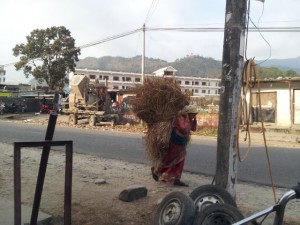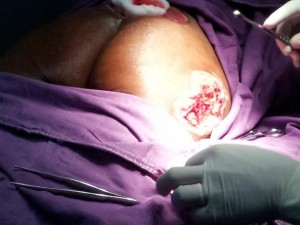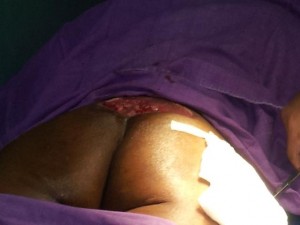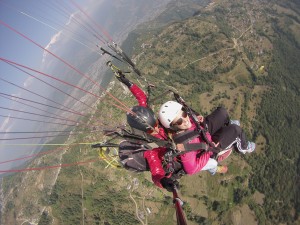Spinal cord injuries are not all that uncommon here in Nepal. Falls and, perhaps not surprisingly, motor vehicle accidents are a common causes. This week Green Pastures Hospital and Rehabilitation Centre (GPHRC) opened a brand new ward for spinal rehab patients, a project supported by the Finland Christian Medical Society and the Finish Government. It will be a step up from the current dark and tired ward to a much brighter place for spinal cord injury patients undergoing their rehabilitation.

The newly opened ward for spinal rehab patients at Green Pastures Hospital and Rehabilitation Centre, Pokhara, Nepal.
A number of spinal cord inpatients are here for pressure sore management. The chief doctor is a dermatologist and very experienced in managing this complication. Unfortunately, many of the sores are very expansive by the time medical care is sought.

A patient's injury was caused by a fall down a bank while carrying a heavy load of food with a strap over her forehead to increase the weight able to be carried.
She was initially taken to a hospital in Kathmandu but, due to the family being very poor, they were unable to access any form of imaging or intensive medical input so the patient was managed conservatively i.e. no treatment, and was discharged. Sadly, this is the patient’s second admission at GPHRC in under a year since the accident for pressure sore management. This time she has multiple pressure sores all over both buttocks, one big enough to place a small child’s fist inside.
Fistulas have developed between the sores, one traveling from a lower to upper pressure sore, over 15cm in length. As she lies on her stomach on a simple foam mattress and blankets, I fear what might form on the front side without careful management. However, the occupational therapist assured me that it is very uncommon to develop pressure sores on the front side and patients can spend months lying like this without too much trouble, despite not being very comfortable.

Fistulas have developed between pressure sores, with one over 15cm in length, on a paraplegic patient.
However, the -10mmHg of pressure is not quite enough to draw out fluid in the larger wounds, one of which is producing about 300ml of pus filled fluid a day. We have had to revert to irrigating with saline and iodine and using honey to promote tissue growth. The little victory with this patient is promising though. Hopefully these wee turtles will be very effective for smaller ulcers on the feet of leprosy and diabetic patients, which was their intended use initially. There are definitely plenty of those here, so the machines have their work cut out for them already.
 This machine and required tubing can be made for total of under 100 NZ$. This is in comparison to the cost of the proper VAC machines which are likely to be more in the vicinity of thousands of NZ dollars. The on-going costs are still not insignificant for this hospital, and time will tell if they can successfully integrate their use in to current practice. However, I think it is so amazing and very inspiring how a bit of thinking outside of the square has given this severely under-resourced hospital hope in accessing technology they could have otherwise never dreamed of having.
This machine and required tubing can be made for total of under 100 NZ$. This is in comparison to the cost of the proper VAC machines which are likely to be more in the vicinity of thousands of NZ dollars. The on-going costs are still not insignificant for this hospital, and time will tell if they can successfully integrate their use in to current practice. However, I think it is so amazing and very inspiring how a bit of thinking outside of the square has given this severely under-resourced hospital hope in accessing technology they could have otherwise never dreamed of having.
The second patient and the photo belong to a quadriplegic 50 year old male who, from the vague history, reportedly fell while walking, fracturing his C5-C6 vertebrae 3 months ago. He is badly dehydrated and de-conditioned, with not much more than skin hanging off his now tiny frame – another risk factor for pressure sore development. This patient has developed absolutely huge pressure sores over his sacrum and upper thigh region on both legs.
We took him to surgery to debride away the dead tissue. The smell was awful as we cleared away the infected tissue and dead muscle on the thigh wounds – the reason for all of the flies attracted to his corner of the ward since admission! The doctor had to go deeper and deeper to try and find some vitalized tissue beneath. The sacral wound is as big as a saucer in circumference, the sacral bones just sitting there exposed to the world.
The patient frequently spasmed on the table, he has no bowel or bladder control and I can’t imagine there is much quality of life for this poor man. The management plan is two days of iodine soaked swabs to help clear away any bugs, followed by honey dressings to promote new tissue growth and then normal saline washes until they have healed. It is going to be a long arduous process and he will likely remain here for months – that is if an overwhelming sepsis doesn’t become the victor in this battle beforehand.
Pressure sores occur with frightening speed and initial signs of tissue break down can be hard to spot. It is relatively easy to see how such situations develop, and it is certainly not for the lack of love and care from family members. The patient and their carers are on their own when they return home from hospital, they do their very best to juggle caring for their loved one and maintaining a livelihood for their families. There is a real shortage of community based care and support here to provide education and resources to help prevent these complications. Green Pastures is one of too few services trying to meet these needs of the 8-million people living in Western Nepal.
By chance, I was able to practice some neurology this week as a consequence of the infamous Nepalese road-code. I was asked to perform a full neurological examination on a Saudi Arabian man who is here for rehabilitation post a traumatic brain injury. Fortunately with OSCE’s not far behind me, I am a little bit practiced at doing those so gladly jumped at the opportunity.
This particular patient was hit by a motorbike which rode up onto the foot path on the wrong side at speed to pass other vehicles. The patient suffered a large brain bleed as well as a badly fractured leg. After being transferred to two hospitals, he was finally able to access the neurosurgical and orthopaedic care required. Soon after he suffered a spontaneous brain bleed and after more surgery was sent back to ICU. Here he developed two very bad chest infections as well.
He was in hospital all together over 1 month which I thought wasn’t too bad for someone who was at death’s door on arrival. In Nepal, the person who causes the injury is liable to pay for all of the hospital and rehabilitation care required by the patient – only if they can’t get away without being caught that is! If they do manage to escape the scene unknown, the victim and their family are left with no option but to pay for the required care themselves, as horrible as that seems.
Either way, both parties rarely have money to foot such bills leaving them with the only option of taking out large expensive loans. They will spend the rest of their working lives and beyond trying to pay this off. One does not need much of an imagination to see what this system means for the quality and quantity of care received by patients who cannot afford the care they need.
This patient has a long recovery journey ahead not just physically but also mentally. He is very much struggling with his new reality. He currently requires help with all basic daily activities, he cannot work, and as for trekking, well that is currently a motivator for his rehabilitation. When you see these disasters, the terrible risky driving is no longer very amusing.

Natalie paraglides off Sarangkot with a guide going from thermal to thermal using hawks vultures and other paragliders to find where to get the best lift
My guide Eli, expertly guided us from thermal to thermal using hawks, vultures and other paragliders to find where we would get the best lift. It was such an amazing experience, the only problem was that it had to end!
The other exciting news from Pokhara the week is that the garbage truck came! While that may not sound very exciting to you or I, the loud beeping horn of the garbage truck is indeed music to the ears of the residents here. Unfortunately since winning the government contract operate on their terms, the garbage collection company pick-ups can occur at anytime of the day, on any day of the week, with 1, 2, 3 weeks or 4 months between visits. As you can imagine people have collected a lot of waste with such infrequent collections and were literally running down the street after the truck hurling their waste in to the back. It was quite an amazing sight. It is now easier see why there is so much litter on the streets and waterways!

No comments yet.
Leave a comment